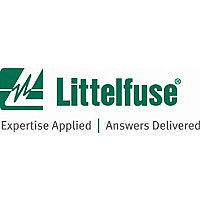SP3050-04HTG Littelfuse Inc, SP3050-04HTG Datasheet - Page 5

SP3050-04HTG
Manufacturer Part Number
SP3050-04HTG
Description
TVS DIODE ARRAY 4CH 5V SOT23-6
Manufacturer
Littelfuse Inc
Series
SP3050r
Specifications of SP3050-04HTG
Package / Case
SOT-23-6
Voltage - Reverse Standoff (typ)
5V
Polarization
4 Channel Array - Bidirectional
Mounting Type
Surface Mount
Applications
General Purpose
Number Of Circuits
4
Voltage - Working
6V
Voltage - Clamping
15V
Technology
Diode Array
Clamping Voltage
11.5 V
Current Rating
10 A
Operating Voltage
6 V
Channels
4 Channels
Capacitance
2 pF
Termination Style
Solder Pad
Operating Temperature Range
- 40 C to + 85 C
Lead Free Status / RoHS Status
Lead free / RoHS Compliant
Power (watts)
-
Lead Free Status / Rohs Status
Lead free / RoHS Compliant
Other names
F3467TR
SP3050-04H
SP3050-04H
Available stocks
Company
Part Number
Manufacturer
Quantity
Price
Company:
Part Number:
SP3050-04HTG
Manufacturer:
ATMEL
Quantity:
4 420
Part Number:
SP3050-04HTG
Manufacturer:
LITTELFU
Quantity:
20 000
oVeRCuRReNt eVeNts
Excessive current events can lead to catastrophic
failures in electronic circuits. These failures can
result in safety hazards such as fire, shock, or
explosion. Common types of overcurrent
threats include:
overload
Overloads occur when more current is allowed to
flow through a circuit path than it was designed
to carry. This excess current can generate and
accumulate heat and result in complete circuit
destruction and possible fire, electrocution or
explosion. Sources of overload can include:
•
•
•
•
short Circuit
Short circuits occur when one conducting path
comes in contact with another conducting path or
with ground, such as may occur due to a loose wire,
insulation breakdown, or contact with water. These
conditions can increase the likelihood of arcs, shock,
or fire hazards.
The principal forms of protection against overcurrent
conditions include fuses and resettable positive
temperature coefficient (PTC) thermistors.
Their function is to limit current to acceptable
levels and prevent catastrophic events, and during
acceptable conditions act dormant with a minimal
amount of resistance to the circuit.
Fuses will completely stop the flow of current when
opened, which may be desired with sensitive,
expensive or critical applications.
PTCs offer the ability to re-set for withstanding
most minor, common and recurring overcurrent
events. They will allow safe levels of current to pass
continuously, and during major overcurrent events,
increase in resistance as they heat, to restrict the
flow of current. When the overcurrent event ends,
the device resets to its normal operating state.
Construction hazards cutting across power mains
Equipment failure in the power grid
Environmental hazards on the power grid
Short spikes of energy within the circuit as a result
of turning equipment on or off
VoLtAge tRANsieNt eVeNts
Voltage transients are short duration surges or
spikes. Unsuppressed, they may damage circuits and
components, and result in complete system failure.
Below are descriptions of common types of voltage
transients, and technologies to reduce their effects:
electrostatic discharge (esd)
Damage from ESD is generally caused by the transfer
of static electrical charge from a body to an electronic
circuit. It may result in faulty circuit operation, latent
defects, and even catastrophic failure of sensitive
components. ESD suppressors must have very fast
response times and handle high peak voltages and
currents for short durations. Littelfuse offers a range
of PulseGuard
(MLVs) and SPA™ Silicon Protection Array products
designed to suppress these types of events
(see page 16).
inductive Load switching
Switching of inductive loads, such as those that occur
with transformers, generators, motors, and relays, can
create transients up to hundreds of volts and amps,
and can last as long as 400 milliseconds, affecting both
AC and DC circuits. For these applications, commonly
used suppressor devices include Metal Oxide Varistors
(MOVs), Gas Discharge Tubes (GDTs), and Transient
Voltage Suppression (TVS) Diodes.
Lightning induced transient
Most transients induced by nearby lightning strikes
result in an electromagnetic disturbance on electrical and
communication lines connected to electronic equipment.
Devices that protect against these transients must have a
fast response time and must be able to dissipate a large
amount of energy. Littelfuse Metal Oxide Varistor (MOV),
TVS Diode and GDT products are typically used to protect
against these events. Look to Littelfuse SIDACtor
SPA™ products for Telecom/Datacom requirements
(see page 8).
Automotive Load dump
Load dump refers to what happens to the supply voltage
in a vehicle when a load is removed. If a load is removed
rapidly (such as when the battery is disconnected while
the engine is running), the voltage may spike before
stabilizing and damage electronic components. In a
typical 12V circuit, load dump can rise as high as 120V
and take 400 ms to decay—more than enough to cause
serious damage. Littelfuse offers a wide range of TVS
Diode and Multi-Layer Varistor (MLV) products designed
to protect against these types of events.
®
ESD suppressors, Multi-Layer Varistors
www.littelfuse.com/designsupport
®
and
3






















